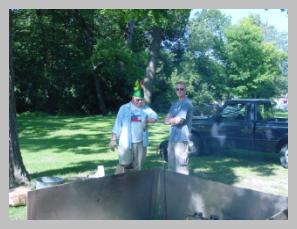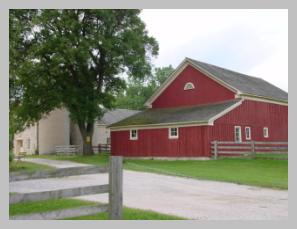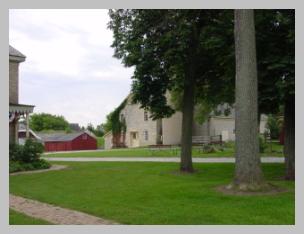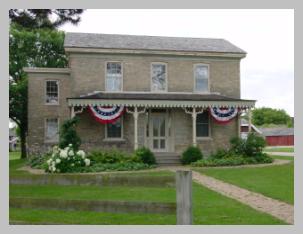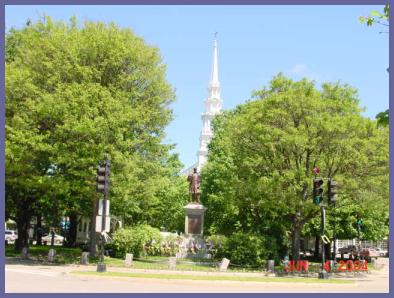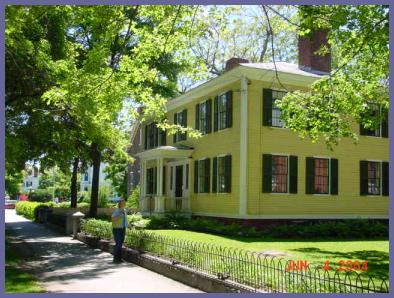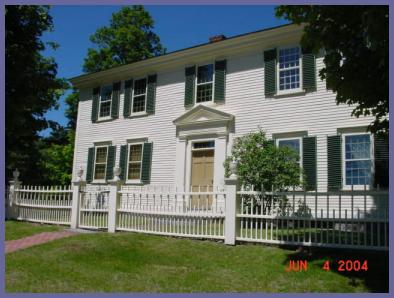Returned from the annual family get together “Chickenfest”. Jerry and Tony Bozich do the cooking. My cousin Dorothy organizes the party. It has become a big event that a lot of people look forward to (how about that for great grammar dangling.)
It all starts with the chickens. Jerry seasons them from the inside out and then puts them on long pipes. They kind of get their heads stuck up their asses, a kind of Abu Ghraib for chickens. You can see from the picture. The machine is a local design. Jerry got some old man friend of his to make it. It is literally made of junk – pieces of metal that the old guy scavenged up. But it works well. The chickens cook slowly and the meat remains juicy. The result is chicken as good as I have had anywhere and better than most.
I personally still feel the pain from last year’s Chickenfest revelation when I learned that my grandfather was NOT a brew master, as I had always believed. He was, in fact, a candy maker. Beer . . . candy? Candy is not as cool. It wasn’t even famous candy like M&M, Three Musketeers or Milky Way. He made caramels and hard candies of dubious trademark. I really believed he was a brew master. Why? I thought he was a brew master because when he took the glory road he left a bottle of “Meisterbrau” (or brau meister – don’t recall exactly) beer in our fridge. My mother never threw it out and it dwelled permanently in the space between the catsup and mustard for at least twenty years. When we replaced our gas fridge with a new and improved electric one, the beer moved too. It was a fixture of the fridge. For as long as I could remember I saw that bottle every time I needed some cheese or coke and I ate a lot of cheese and drank a lot of coke. Meisterbrau was grandpa’s beer. I started associating Meisterbrau – brew master with my grandfather. We lived in Milwaukee, the most famous beer city of North America. The leap of imagination was a short one. Grandpa was a brew master. Meisterbrau, as I learned later, was not a good beer and not even made in Milwaukee. Its little known claim to distinction is that it was the precursor of all light beer. Meisterbrau tried unsuccessfully to make a light beer in the early 1970s. Miller bought Meisterbrau, tweaked the formula a little and created Miller Light. Anyway, I blame Meisterbrau as the source of my confusion. A lot of family histories are like that, I suspect. I am thinking of going with the original legend, maybe even embellish it with scandal to explain how we lost whatever great fortune we once enjoyed. Why tarnish the beauty of the thing with unnecessary accuracy.
Whether the old guy was a brew master or not, Beer was and is still a big part of family gatherings, but beer drinking is a declining art among us. The older generation failed to pass the torch. In days of yore, the men (they were real men in those days) would sit around a keg of beer and drink prodigious amounts of the liquid bread. Past, present and future blurred into a soft amber glow. In the parlance of the time, they would all get a snoot full. Now the our gatherings are relatively sober affairs. We still have our share of characters, as you can see from the pictures. Everyone is healthier, however, and that is a good thing. The beer now comes in bottles and cans and there is greater variety. You count cans and bottles individually. Bottles slow the drinking. The keg tended to facilitate sluckin it down, as cups held more than a standard can and you tended to fill it up again before it was empty. In other words, you never really knew how much you were drinking because you had a bottomless cup.
Milwaukee was especially pleasant during my visit, with highs in the seventies with low humidity and a breeze off the lake. I drove around a little and ended up near Whitnall Park. I used to ride my bike to Whitnall Park along Grange Avenue. I don’t recognize most of the way any more. What used to be a country road is now a suburban street, but some is preserved as park. Just past 76th Street stands Jeremiah Curtin’s house and an old lime factory. Jeremiah Curtin was a moderately famous linguist, who wrote a history of the Mongols and translated Szienkeiwicz (for those less up on Polish culture, he wrote “Quo Vadis” and won a Nobel prize in literature about 100 years ago.) Above are pictures of the old lime farm. It is that quintessential Wisconsin style. The house is made out of crème city brick, the kind you can find only around Milwaukee. The other building is stone. It would be nice to make a community in a place like that.
I went down to my old running trail in Grant/Warnemont Park. It is a really nice running trail with a little roll but nothing a reasonable person could call a hill. I ran the distance in 24:21, which is 25% slower than I used to run it when I wore a younger man’s shoes, but it was still fun. That trail was a solace through the worst of my unsuccessful job searching back in the early 1980s. I think I applied at every major firm in North America. They were amused, but not interested. The more rejection letters I got, the farther I ran. I was probably in the best aerobic condition of my life. Sometimes I ran all the way through Grant Park to the Root River Parkway, about 12 miles. I am fatter now and I can’t run that far. I blame the economy. The economy has not been that bad since then, so I have no compulsion to run very far. The trail has changed a lot since I started there. A very big oak tree that used to guard one of the kinks in the trail died some time back. Most of the birch trees have died and even the stumps have rotted into compost. A birch forest is ephemeral everywhere, but especially around here. Individual trees don’t live long and won’t reproduce naturally in southeastern Wisconsin.
The trail used to run through a mixed meadow and forest that looked like the ecosystem you would expect 100 miles farther north. Whether through indolence or design, the park system has let some places return to nature. I used to think that letting things return to nature was an unmitigated blessing, but on reflection I recall a beautiful view of the lake around the second trail bend, kind of a v shaped field with wild flowers framed by tamarack trees. It looked natural, but was not. It takes a lot of planning to be spontaneous and somebody planned it well.
Tamaracks are not native to this part of Wisconsin, so they must have been planted about forty years ago. They backed up against the native basswoods and maples and looked really good especially in the fall, when their gold needles burned against the crimson of the maples. The park system also planted some Austrian pines “randomly” in the fields about the same time. They stayed dark green through the year. It was a work of art. The tamaracks and pines are still there, but you can’t see them unless you look closely in the bushes. The exquisite interaction of tamarack, maple and pine is now replaced by the pea green banality of the box elder. Some of the box elders and ash reach about 20 or 30 feet. Box elders are nice in their place (generally next to rusty railroad tracks and pushing up through the ruins of abandoned warehouses next to rusty railroad tracks) but I never did like their unique fragrance and they block the view. That’s not good. I loved to watch the lake and the joys and sorrows of its changing face. Natural succession won’t stop, of course. The box elders are transition species. Some of the ash trees will remain but in about fifty years maples, basswoods and maybe a couple of beeches, will cover the whole place. I won’t see that and nobody will see the lake through them.

